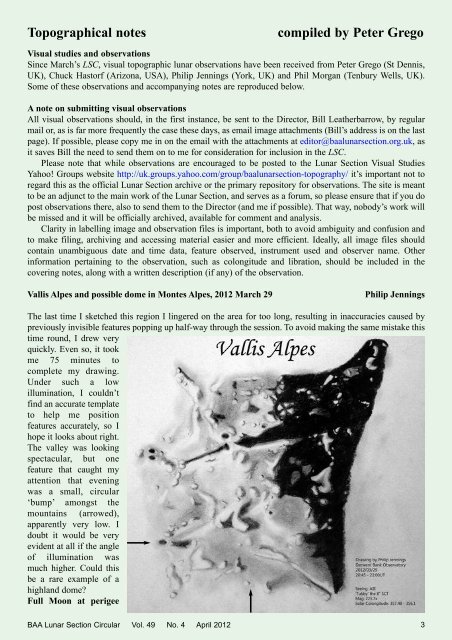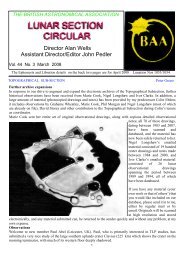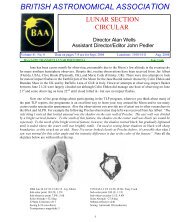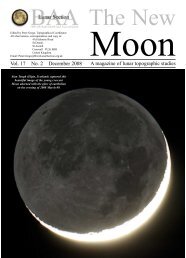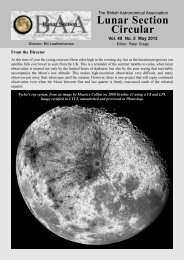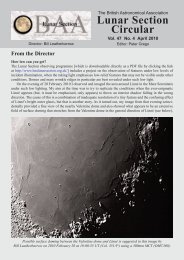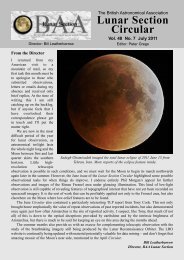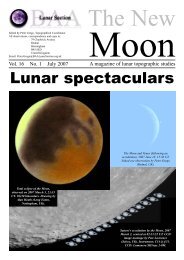Vol 49, No 4, April 2012 - BAA Lunar Section
Vol 49, No 4, April 2012 - BAA Lunar Section
Vol 49, No 4, April 2012 - BAA Lunar Section
Create successful ePaper yourself
Turn your PDF publications into a flip-book with our unique Google optimized e-Paper software.
Topographical notes<br />
compiled by Peter Grego<br />
Visual studies and observations<br />
Since March’s LSC, visual topographic lunar observations have been received from Peter Grego (St Dennis,<br />
UK), Chuck Hastorf (Arizona, USA), Philip Jennings (York, UK) and Phil Morgan (Tenbury Wells, UK).<br />
Some of these observations and accompanying notes are reproduced below.<br />
A note on submitting visual observations<br />
All visual observations should, in the first instance, be sent to the Director, Bill Leatherbarrow, by regular<br />
mail or, as is far more frequently the case these days, as email image attachments (Bill’s address is on the last<br />
page). If possible, please copy me in on the email with the attachments at editor@baalunarsection.org.uk, as<br />
it saves Bill the need to send them on to me for consideration for inclusion in the LSC.<br />
Please note that while observations are encouraged to be posted to the <strong>Lunar</strong> <strong>Section</strong> Visual Studies<br />
Yahoo! Groups website http://uk.groups.yahoo.com/group/baalunarsection-topography/ it’s important not to<br />
regard this as the official <strong>Lunar</strong> <strong>Section</strong> archive or the primary repository for observations. The site is meant<br />
to be an adjunct to the main work of the <strong>Lunar</strong> <strong>Section</strong>, and serves as a forum, so please ensure that if you do<br />
post observations there, also to send them to the Director (and me if possible). That way, nobody’s work will<br />
be missed and it will be officially archived, available for comment and analysis.<br />
Clarity in labelling image and observation files is important, both to avoid ambiguity and confusion and<br />
to make filing, archiving and accessing material easier and more efficient. Ideally, all image files should<br />
contain unambiguous date and time data, feature observed, instrument used and observer name. Other<br />
information pertaining to the observation, such as colongitude and libration, should be included in the<br />
covering notes, along with a written description (if any) of the observation.<br />
Vallis Alpes and possible dome in Montes Alpes, <strong>2012</strong> March 29<br />
Philip Jennings<br />
The last time I sketched this region I lingered on the area for too long, resulting in inaccuracies caused by<br />
previously invisible features popping up half-way through the session. To avoid making the same mistake this<br />
time round, I drew very<br />
quickly. Even so, it took<br />
me 75 minutes to<br />
complete my drawing.<br />
Under such a low<br />
illumination, I couldn’t<br />
find an accurate template<br />
to help me position<br />
features accurately, so I<br />
hope it looks about right.<br />
The valley was looking<br />
spectacular, but one<br />
feature that caught my<br />
attention that evening<br />
was a small, circular<br />
‘bump’ amongst the<br />
mountains (arrowed),<br />
apparently very low. I<br />
doubt it would be very<br />
evident at all if the angle<br />
of illumination was<br />
much higher. Could this<br />
be a rare example of a<br />
highland dome<br />
Full Moon at perigee<br />
<strong>BAA</strong> <strong>Lunar</strong> <strong>Section</strong> Circular <strong>Vol</strong>. <strong>49</strong> <strong>No</strong>. 4 <strong>April</strong> <strong>2012</strong> 3


